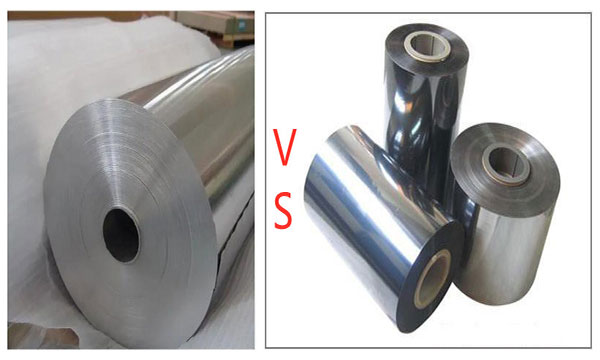Aluminum foil VS metallized PET Film (MPET): Applications Differences
Aluminum foil has been used for more than 100 years especially in the packaging industry. But meanwhile, a serious competitor has entered the arena. Metallized PET film covers an ever-growing range of applications. Making it one of the fastest growing segments in the flexible packaging market.
At first sight, the two types of films are similar. But, they offer very different properties, making each of them more or worse suitable depending on the applications

Properties of aluminum foil
Aluminum foil is usually made of pure aluminum, with an aluminum content of at least 99%. In a series of passes through rolling mills, the aluminum reaches the desired thickness.
Very thin foils are double-rolled together in the last step and later, separated again. This process produces two kinds of natural finishes: the outer side of the foil touching the millwork rolls gets a “bright” finish. While the side contacting the other aluminum foil (foil-to-foil) gets a “matte” finish.
The aluminum is solidified by the cold rolling, becoming hard and brittle.
Even so, subsequent thermal treatment in an annealing furnace makes the films soft and flexible again.
Food packaging made of AluminiumChocolate wrapping made of Aluminium foil.
Aluminum foils with a thickness of about 12-20 μ possess barrier properties. This means that those foils are impermeable to water and gases. Thinner foils cannot guarantee the same 100% barrier properties. But, they also offer barrier properties and ensure that food stays fresh longer because of its light protection.
Aluminum foil is easily deformable without losing its barrier properties.
Aluminum foil is physiologically harmless to food. But, acidic, alkaline, and salty foods should not be in contact with the film.
Aluminum foil is light and resistant to water, water vapor, grease, and gas. It reflects light, heat, and UV rays and does not charge. Moreover, it is fire resistant and easy to recycle.
For packaging, it is rarely used pure aluminum foil. In most cases, the aluminum foil is laminated with plastic films (eg PET, PE, or PP) or paper. One then speaks of aluminum composite films.
Composite films have some advantages over pure aluminum foils. For example, higher resistance to rusts and/or stiffness. Besides, aluminum foil can be painted and printed to meet the requirements of modern packaging.
Aluminum bands can be deep-drawn to produce containers or trays and cans. It then keeps the deep-drawn shape. Aluminum can be bent and folded without losing its barrier properties.
Properties of Metallized PET Film
Aluminum coffee capsules coffee capsules are also made of Metallized PET Film.In contrast to aluminum foils, it is are made entirely of light metal.
Metalized PET foils are plastic foils that are only evaporated with aluminum powder in a high vacuum.
For this process, it is used pure aluminum in powder form with an aluminum content of at least 99,98%. The films produced this way get a metallic shine and thereby achieve a special optical effect.
Also to the optical effect, the aluminum vaporization serves in particular to improve its barrier effects against vapours, gases and aromas in comparison to non-metalized plastic film.
The metalized PET films are less gas-tight than “real” aluminum foil. But more tear-resistant, more flexible, and lighter.
Also, they are less sensitive to corrosion and not as winkle-prone as pure aluminum foil.You can see through PET-met foils,not through aluminum foils.
PET-metallized films are made of only 1% of the aluminum that would have been needed for an aluminum foil.
Thus, PET metalized film is especially interesting as a cost-effective and more friendly alternative to aluminum.
Conact
If you have any need about Aluminum foil or Metallized PET Film,kindly contact freely.